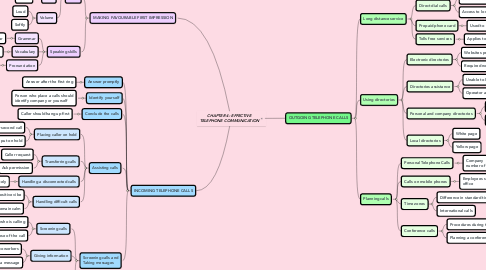
1. INCOMING TELEPHONE CALLS
1.1. Answer promptly
1.1.1. Answer after the first ring
1.2. Identify yourself
1.2.1. Person who place a calls should identify company or yourself
1.3. Conclude the calls
1.3.1. Caller should hang up first
1.4. Assisting calls
1.4.1. Placing caller on hold
1.4.1.1. Answer second call
1.4.1.2. Ask permission to put on hold
1.4.2. Transferring calls
1.4.2.1. Caller request
1.4.2.2. Ask permission
1.4.3. Handling a disconnected calls
1.4.3.1. Caller should call back immediately
1.4.4. Handling difficult calls
1.4.4.1. Present a positive vibe
1.4.4.2. Remain calm
1.5. Screening calls and Taking messages
1.5.1. Screening calls
1.5.1.1. Determine who is calling
1.5.1.2. Purpose of the call
1.5.2. Giving information
1.5.2.1. Calls fo coworkers
1.5.2.2. Offer to take a message
1.5.3. Taking messages
1.5.3.1. Each message should include all the required data
1.5.3.2. Using a computer messages offer some advantages
2. MAKING FAVOURABLE FIRST IMPRESSION
2.1. Voice
2.1.1. Tone
2.1.1.1. High-pitch
2.1.1.2. Low-pitch
2.1.2. Pace
2.1.2.1. Speed
2.1.3. Volume
2.1.3.1. Loud
2.1.3.2. Softly
2.2. Speaking skills
2.2.1. Grammar
2.2.1.1. Basic grammar
2.2.2. Vocabulary
2.2.2.1. Learn new terms
2.2.3. Pronunciation
2.2.3.1. Enunciate clearly
3. OUTGOING TELEPHONE CALLS
3.1. Long distance service
3.1.1. Direct dial calls
3.1.1.1. Station to station calls
3.1.1.2. Access to long distance line
3.1.2. Prepaid phone card
3.1.2.1. Used to pay for a certain number
3.1.3. Tolls free services
3.1.3.1. Applies to ncoming calls
3.2. Using directories
3.2.1. Electronic directories
3.2.1.1. Websites provide telephone numberrs
3.2.1.2. Required no payment
3.2.2. Directories assistance
3.2.2.1. Unable to locate telephone numbers
3.2.2.2. Operator assisted calls
3.2.3. Personal and company directories
3.2.3.1. Frequently calls list
3.2.3.2. Identify yourself and company
3.2.4. Local directories
3.2.4.1. White page
3.2.4.2. Yellow page
3.3. Planning calls
3.3.1. Personal Telephone Calls
3.3.1.1. Company permit a limited number of personal calls
3.3.2. Calls on mobile phones
3.3.2.1. Employees spend a lot of time away from office
3.3.3. Time zones
3.3.3.1. Difference in standard time zone
3.3.3.2. International calls
3.3.4. Conference calls
3.3.4.1. Procedures during the calls
3.3.4.2. Planning a conference calls
